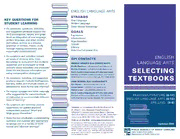Table Of ContentENGLISH LANGUAGE ARTS
STRANDS
KEY QUESTIONS FOR
Oral Language
STUDENT LEARNING Written Language
Other Media/Technology
• Do selections, questions, activities,
and suggested products support the GOALS
SCS philosophies, values, and goals
Expressive
(such as integration of oral language,
Informational
written language, and other media/
Argumentative
technology, writing as a process,
Critical
grammar in context, literary study
Literary
through making connections and
Grammar/Language Arts
meaningful conversations)?
• Do questions and activities include ENGLISH
all levels of thinking skills, from DPI CONTACTS
knowledge to evaluation? Are students LANGUAGE ARTS
MIDDLE GRADES ELA CONSULTANTS
supported and encouraged to think
Phyllis Blackmon:: [email protected]
critically about selections and products?
Patricia Chalmers:: [email protected] SELECTING
Does the text include information on
North Carolina Department of Public Instruction
using metacognitive strategies?
Division of Middle Grades Education, ELA Section
TEXTBOOKS
6344 Mail Service Center, Raleigh, NC 27699-6344
• Do questions, activities, and suggested
products support multiple intelligences,
HIGHSCHOOL ELA CONSULTANTS
learning styles, and multiple means of
Kim Bowen:: [email protected]
assessments, both formal and informal?
Louise Burner:: [email protected]
Gladys Logan:: [email protected]
• Do teacher sidebars and other materials
North Carolina Department of Public Instruction
offer suggestions for varied methods
READING/LITERATURE (6-12)
Division of Secondary Education, ELA Section
of instruction to accommodate different
6345 Mail Service Center, Raleigh, NC 27699-6345 ENGLISH LANGUAGE ARTS (6-12)
ways of learning?
SPELLING (6-8).
• Do questions and activities provide
opportunity for guided practice? Inquiries or complaints should be directed to:
independent practice? Small and Dr. Elsie C. Leak, Associate Superintendent
Office of Curriculum and School Reform Services
large group interaction?
6307 Mail Service Center, Raleigh, NC 27699-6307
Telephone: (919) 807-3761; Fax: (919) 807-3767
• Does the text emphasize understanding
audience and purpose and appropriate Visit us on the Web: www.ncpublicschools.org
language use in a variety of both In compliance with federal law, NC Public Schools Updated 2005
administers all state-operated educational programs,
formal and informal settings? employment activities and admissions without
discrimination because of race, religion, national or
PUBLIC SCHOOLS OF NORTH CAROLINA
ethnic origin, color, age, military service, disability,
or gender, except where exemption is appropriate State Board of Education
and allowed by law. Department of Public Instruction
REFLECTIONS BEFORE ADOPTING A TEXT
SELECTING TEXTBOOKS can be a
Textbooks are designed as a tool to help teachers implement the Standard Course of Study (SCS).
difficult and overwhelming process. Inundated
Textbooks do not replace good teaching – they supplement it.
with choices of texts and supplemental materi-
als, teachers have many factors to consider. Current state assessments (EOG/EOC) and (writing) match the clarified Standard Course of Study
This brochure is designed to assist with the (SCS). You should not select a textbook based on state assessments. Instead, select a text that will
process by offering both key questions for dis- best support the implementation of the SCS and one that best meets the unique needs
cussion and criteria for evaluating textbooks. of your school’s students.
Before beginning to review the possibilities, Make sure your school has a consistent philosophy of instruction and that every teacher who
make sure you have become familiar with the will be using the selected texts, including special education teachers, has a voice in the process.
new English Language Arts Standard Course
You will face many choices. Weigh all options and select carefully.
of Study – both its philosophy and its specific
outcomes for students. Discussing the state
and local standards along with your school’s
expectations can help teachers understand CRITERIA FOR REVIEW STUDENT TEXT CONTAINS:
guiding principles behind the use of whichever
The following criteria have been adapted from • comprehensive and easy-to-use glossaries,
textbook is selected.
the textbook review guidelines by the teacher bibliographies, indices, appendices, and
Although literature, language arts and spelling review committees.All books on the state tables of contents
textbooks have separate reviews, please adoption list should have met these criteria;
• formatting which assists students in
remember the integrated nature of the curricu- you may find them helpful while examining
organizing and processing information
lum. Isolated reading selections, grammar drills, additional materials.
such as advance organizers, bold-face print,
and vocabulary/spelling are not compatible with
and glossing of pertinent vocabulary
the new philosophy and standards. All three
SELECTIONS ARE:
strands (Oral Language, Written Language, and • current, relevant and appealing graphic
Other Media/Technology) should be represented • well-written elements (illustrations, maps, charts,
in the text materials through selections, activi- timelines, etc.)
• culturally diverse (in geographic regions,
ties, products, and suggestions for extensions
time periods, gender, and ethnicity)
of student learning. Texts should represent all TEACHER’S MATERIALS OFFER
• appropriately challenging
genres (fiction, nonfiction, poetry, and drama) RESOURCES SUCH AS:
and environments (expressive, informational, • interesting to culturally diverse, hetero-
• Suggestions for evaluation, remediation,
argumentative, and critical). Furthermore, gram- geneous groups
acceleration, feedback, and motivation
mar and language usage should have students
• balanced and objective in treatment of
to study and practice language skills and devel- • Indices for themes, genres, authors, etc.
social issues, religion, ethnicity and gender
op understanding of effective communication
• Suggestions for use of ancillary materials,
for different purposes, to different audiences, • inclusive of a variety of genres (fiction,
professional readings, and lists of additional
and in different contexts. Thus, the criteria for non-fiction, poetry, and drama)
resources
review can apply to materials for all aspects of
• inclusive of a variety of literary environments
• Support development of vocabulary and
the curriculum.
(expressive, informational, argumentative,
test-taking skills
critical)
• Suggestions for extension of learning and
integration across the curriculum

